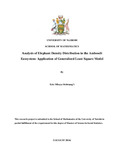| dc.contributor.author | Ochwang’i, Eric M | |
| dc.date.accessioned | 2014-08-04T11:10:59Z | |
| dc.date.available | 2014-08-04T11:10:59Z | |
| dc.date.issued | 2014-08 | |
| dc.identifier.citation | Masters of Science in Social Statistics, University of Nairobi, 2014 | en_US |
| dc.identifier.uri | http://hdl.handle.net/11295/73604 | |
| dc.description.abstract | Elephant population has risen steadily in Amboseli National park since the government
enhanced its efforts in combating poaching. However, human population increase and
settlements have impacted on vegetation composition leading to a shift in vegetation structure.
Due to these changes woody vegetation has shrank to less than 10% and is now dominated by
grassland and swamp. We used long-term ACP data to investigate whether human settlement,
NDVI and vegetation biomass have significant impact on elephant density distributions over
time and further determined the long-term spatial population distribution of elephants in
Amboseli. Results from a generalized least square model showed that NDVI, human settlement
and vegetation biomass significantly influence elephant density distribution.
The spatial density distribution maps for elephants showed that elephant densities were
high inside the park during dry season basically because of the swamp which is located inside the
park and it’s considered as the main source of water and food. However, during wet season
elephants move freely in and outside the park. Spatial density distribution maps for decades
showed that elephant densities were very low and evenly distributed during the 1990 decade;
concentration for other decades was higher inside the park compared to outside.
A generalized spatial least square model developed to determine the effect of seasonal
elephant density distributions on vegetation showed that during wet season elephants have no
significant effect on vegetation but they were found to be significant during dry season. | en_US |
| dc.language.iso | en | en_US |
| dc.publisher | University of Nairobi | en_US |
| dc.title | Analysis Of Elephant Density Distribution In The Amboseli Ecosystem: Application Of Generalized Least Square Model | en_US |
| dc.type | Thesis | en_US |
| dc.type.material | en_US | en_US |


